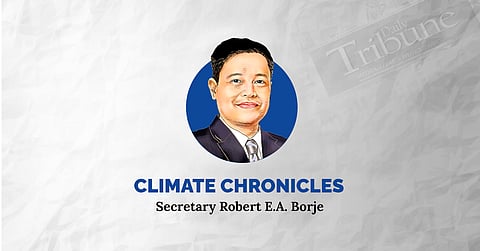
- NEWS
- the EDIT
- COMMENTARY
- BUSINESS
- LIFE
- SHOW
- ACTION
- GLOBAL GOALS
- SNAPS
- DYARYO TIRADA
- MORE

For the past decades, our traditional disaster response systems have been designed to brace for and address sudden-onset events — tropical cyclones tracked by names, dates, and wind speeds; earthquakes measured by magnitude and reach; and floods recorded by the number of affected families and damaged facilities. These are the disasters that strike quickly and visibly, drawing immediate action and public attention.
But not all disasters hit suddenly, or even come with a warning. Some occur gradually, altering ecosystems and disrupting lives and livelihoods over months or years. These are the slow-onset events of climate change known as sea level rise, ocean acidification, salinization, biodiversity loss, and long-term land and forest degradation. They, too, are measurable, but their slow pace usually keeps them out of headlines and outside the scope of traditional disaster frameworks.
According to the United Nations Framework Convention on Climate Change, these threats are just as devastating, especially for most at-risk countries such as the Philippines.
We are already living through these unseen storms.
Droughts, saltwater intrusion, extreme heat and rising seas are quietly threatening our food security, health systems, and water access. For instance, sea level rise in the Philippines is occurring at a rate roughly three times higher than the global average, a slow-building threat that is already reshaping our coastlines and displacing communities.
In Cauayan, Negros Occidental, saltwater is contaminating freshwater aquifers, forcing families to rely on expensive water deliveries. Along the southern coastlines of Davao Oriental and Surigao del Sur, coastal erosion is washing away homes and compromising critical infrastructure including evacuation routes and rural health units.
These disasters usually fall outside the scope of conventional risk frameworks, which are developed to respond to immediate crises, not the quiet, cumulative toll of long-term climate threats. By the time their impacts are visible, the damage is already severe and harder to reverse.
This is why the Climate Change Commission (CCC) is working to shift how we approach resilience. Under the leadership of President Ferdinand Marcos Jr., we have developed the National Adaptation Plan (NAP), our long-term strategy to strengthen preparedness and adaptation across sectors and communities. Unlike earlier plans focused on emergency response, the NAP addresses long-term vulnerabilities by outlining actions that prepare our systems for a changing climate.
It includes support for reintegration of displaced communities, climate-resilient infrastructure, and crucially, early warning systems designed not just for typhoons and floods, but for slow-onset events as well. These are coupled with targeted education and awareness efforts that empower people to act early and decisively.
In partnership with local governments, the CCC is also integrating this broader understanding of climate risk into land use planning, infrastructure design, and local development strategies. But this is not the work of the government alone. Everyone — from communities, faith-based organizations and businesses to academic institutions and civil society organizations — must take part in recognizing and responding to these invisible threats. The resilience we build must reflect the risks we actually face, not just the ones that make the news.
This National Disaster Resilience Month, let us not stop at awareness. Climate change does not operate on a calendar. It is a relentless force requiring sustained, whole-of-government, whole-of-society action. This year’s theme, “Kumikilos: Kayang Umaksyon ng Mamamayan na Isabuhay ang Kahandaan ng bawat Isa para maging Ligtas sa Oras ng Sakuna,” asks more from all of us. It calls for readiness that is lived, practiced and shared.
The insidious silence of slow-onset disasters may be the loudest warning we ever get. Resilience must not be reactive. It must be proactive, preventive, inclusive, and attuned to the evolving nature of risk. We must prepare not only for what strikes with immediate impact but also for what erodes our survival one inch, one degree, one storm surge at a time.
